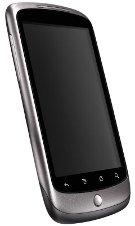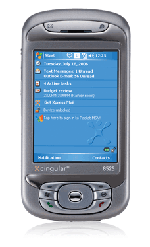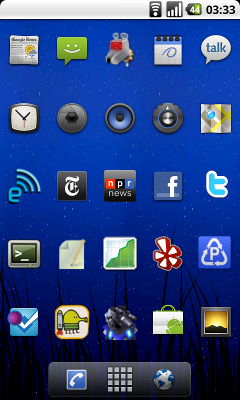Phone Review: Google Nexus One 13 years, 9 months ago by Martey Dodoo
 At the beginning of April, I bought a Nexus One smartphone from Google. It was prohibitively expensive. Since I use AT&T's wireless network and not T-Mobile, I was forced to buy it unsubsidized and without a contract, which cost more than $500. Needless to say, I do not plan on buying another phone for a long time.
At the beginning of April, I bought a Nexus One smartphone from Google. It was prohibitively expensive. Since I use AT&T's wireless network and not T-Mobile, I was forced to buy it unsubsidized and without a contract, which cost more than $500. Needless to say, I do not plan on buying another phone for a long time.
Despite its high cost, I am satisfied with it and its role in my life. While I seem to have acquired a reputation of changing phones as quickly as most people change their socks, I am confident that my Nexus One is a phone that I can "settle down with." This has as much to do with the individual phones I have previously used as the specific attributes of the Nexus One. As a result, this is not a traditional review.
My Mobile Phone History
 My first smartphone was the much-maligned 8525. While I loved the full keyboard and fast 3G Internet access, its Windows Mobile operating system was the source of significant pain and suffering. It became bad enough that I switched back to my previous phone for 9 months. While I eventually switched back,1 I was once again looking for a new mobile companion.
My first smartphone was the much-maligned 8525. While I loved the full keyboard and fast 3G Internet access, its Windows Mobile operating system was the source of significant pain and suffering. It became bad enough that I switched back to my previous phone for 9 months. While I eventually switched back,1 I was once again looking for a new mobile companion.
While visiting Chicago in November 2008, I visited the Nokia Flagship Store. As an early birthday present, my girlfriend offered me the choice of any phone in the store. Conflicted for a while between the N952 and the E71, I eventually chose the latter - the fantastic keyboard won out over the absolutely amazing camera. While I enjoyed the E71's business-oriented features (a slim Blackberry-like profile, hardware keyboard, the ability to switch between "Work" and "Personal" home screens, etc.), using it as a primary cell phone was sometimes disappointing. While the E71 was better than the Blackberries whose design it aped3, it had limited multimedia features and few applications to extend its functionality.
As a result, in October 2009, I bought an unlocked GSM HTC Hero on eBay. I chose this specific phone for a number of reasons, but the main one was because it ran Android. Hankering for a modern mobile operating system (i.e. one that approximated a normal computer within the technical constraints of mobile devices) since I first got a cellphone, I hoped that a Linux-based phone like an Android device would solve some of the frustration I had with previous phones. While the Hero was significantly better, it still had some issues, which is why I ended up switching to a Nexus One after a few months.
The main issue with the Hero was that it was slow. This was caused by two things, both of which were resolved by switching to the Nexus One:
-
a relatively low speed 528 Mhz processor combined with Sense, customized software made by HTC to address some shortfalls in the Android operating system. Rooting the phone (similar to jailbreaking an iPhone) and installing custom firmware helped the phone's speed, but it still cannot compare to the Nexus One' 1 Ghz Snapdragon processor and "stock" Android firmware, both of which are significantly faster.
-
As I noted earlier, I use AT&T. Since the Hero is the European model of the phone, it did not contain the relevant radio frequency bands to work on AT&T's network. While there was evidence that the phone might come to AT&T eventually, I was unwilling to wait. While this meant that I was not horribly disappointed when the phone ended up on Canadian mobile carrier Telus instead of AT&T (the two carriers use the same frequency bands for 3G), it also meant that my Hero was constantly stuck on EDGE, like an original iPhone. My Nexus One is the model with AT&T 3G bands, which allows for significantly faster uploading and downloading.
Features of the Nexus One
Despite the fact that I love taking pictures with my phone, none of my phones have had particularly amazing cameras.4 The 5 megapixel sensor in the Nexus One works well outside and other well-lit areas. Like most phone cameras, it does a poor job in low-light situations (nighttime, discotheques, basements, etc.).
Both the Hero and Nexus One are touchscreen phones, with a similar form factor as the iPhone. I was initially concerned about this, since I spend more time typing information into my phone than speaking to it. However, I quickly took to the virtual on-screen keyboard. While most people seem to prefer the Hero's keyboard (which has been customized by HTC for easier access to numbers and symbols), I have no issues using the stock Android keyboard that the Nexus One came with.
 The quality of a mobile operating system is increasingly determined by the number and variety of the applications available to it. The main reason I stopped using the Nokia E71 was because of a lack of third-party development on its S60 platform. I have been generally happy with the selection available in the Android Market. As you can see from the screenshot of my phone's home screen, the majority of applications that I use often were made by third parties. Unfortunately, there are enough of them that a proper list of indispensable applications would be a project for another day and another essay.
The quality of a mobile operating system is increasingly determined by the number and variety of the applications available to it. The main reason I stopped using the Nokia E71 was because of a lack of third-party development on its S60 platform. I have been generally happy with the selection available in the Android Market. As you can see from the screenshot of my phone's home screen, the majority of applications that I use often were made by third parties. Unfortunately, there are enough of them that a proper list of indispensable applications would be a project for another day and another essay.
I would be using even more applications except for my propensity to wipe my phone and update to a new custom firmware semi-regularly. With the Hero, I was switching between different firmwares almost daily, constantly looking for firmware that included the latest Android features while still maintaining stability. Like many other Android phones that were released with Android 1.5, the Hero was not updated by HTC to Android 2.x for several months after it was released.5 As a result, many of the community firmwares that I was using had various issues (GPS not working, camera stuck at 3 megapixels, etc.) that I forced myself to suffer with in order to use Android 2.0 early. If I failed to wipe my phone clean before installing new versions, I ran the risk of encountering even more esoteric issues.
With the Nexus One, I avoid this. Since the Nexus One does not run HTC's Sense or any of the add-ons that various phone manufacturers have added to their devices, it was the first Android phone to be updated to Android 2.2, the latest version. In addition, it is supported by the excellent community CyanogenMod firmware, which exposes various system settings and new functionality with a minimum of upheaval.
If you are planning on purchasing a Nexus One, you might have a hard time, as Google announced today that they had ran out of inventory. If you live in the United Kingdom, Australia, or a variety of European countries, you can still get one through Vodafone. In South Korea, KT may still have some. In the United States, your best bet would either be eBay or Craigslist, waiting for Google to offer the phone to registered Android developers, or purchasing a similar Android phone (like the Droid Incredible or Evo 4G, both of which are manufactured by HTC) from American carriers Verizon and Sprint, respectively.
-
I think that the number one benefit of a smartphone is that Google Maps in your pocket means never getting lost. In short, I was tired of taking pictures with my cellphone of Google Maps, hoping that I had covered enough of the surrounding area that I would be able to find my bearings when I got near to the location I was going. ↩
-
The Nokia N95 created a significant portion of my original interest in smartphones. Instead of marketing it as a smartphone, Nokia claimed that it was a "multimedia computer." The projects that some of its owners have undertaken on the road, under the sea, and in the air lend some veracity to this claim. ↩
-
The E71 not only had a better web browser than BlackBerries of the time, but its email client also supported more IMAP features. ↩
-
For some reason, as cellphone cameras increase in functionality and performance, their software seems to get worse, as if cameraphone development was some sort of zero-sum game. This seems to be especially true with Sony Ericsson and Nokia - their phones have the best cameras on the market, but often have the least usable software. ↩
-
Android 2.0 was released in October 2009. The GSM Hero was updated to Android 2.1 in late June 2010. ↩